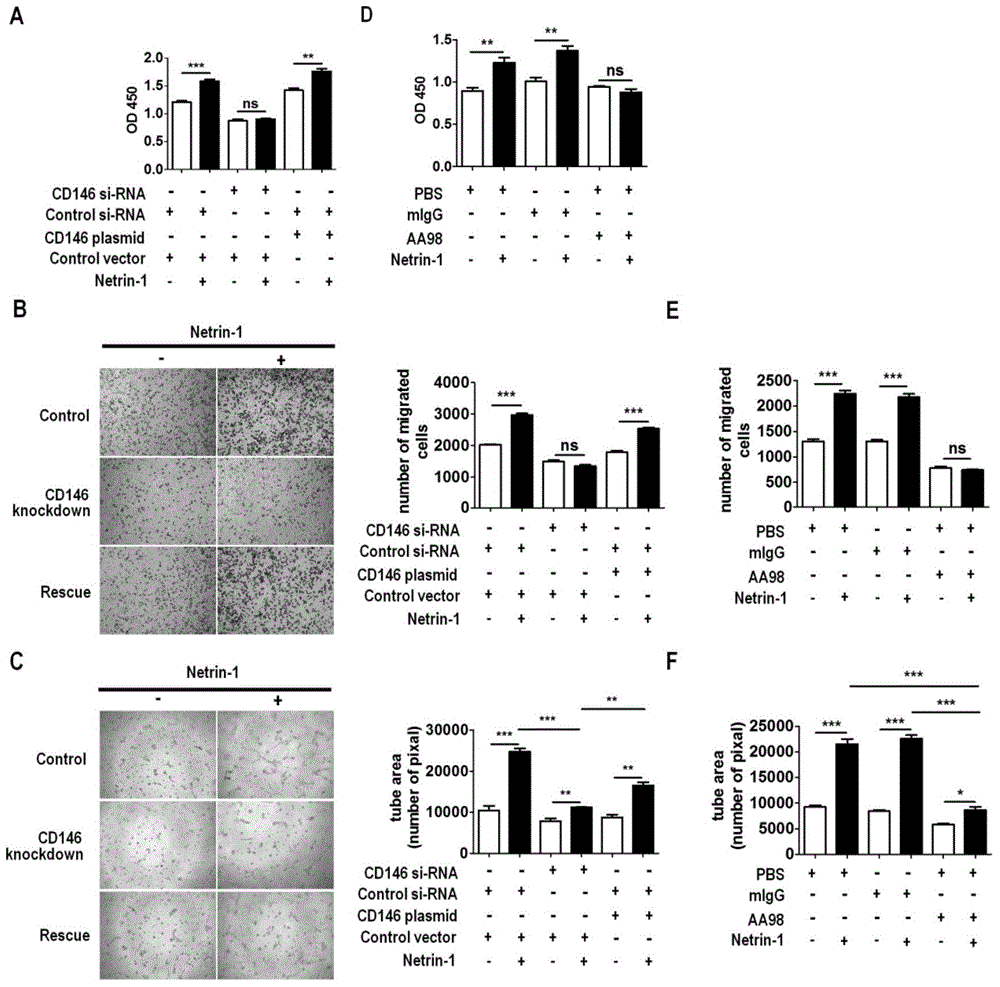Reagent for blocking interaction between Netrin-1 and CD146 and tumor treatment application thereof
A technology of uses and reagents, applied in the field of reagents for blocking the interaction between Netrin-1 and CD146 and their use in tumor therapy, which can solve the problems of unclear mechanisms, unknown receptors and downstream signals, etc.
- Summary
- Abstract
- Description
- Claims
- Application Information
AI Technical Summary
Problems solved by technology
Method used
Image
Examples
Embodiment 1
[0032] Example 1: Interaction of Netrin-1 and CD146 at cellular and in vitro levels
[0033] CD146, as an endothelial cell adhesion molecule, plays a key role in angiogenesis, especially pathological angiogenesis. Netrin-1 has also been reported to promote angiogenic processes, but its receptors are not well understood. In order to study the relationship between the two, we confirmed the direct interaction between Netrin-1 and CD146 at the level of cells and in vitro by co-immunoprecipitation and other methods. Monoclonal antibodies against CD146 can block the interaction between Netrin-1 and CD146.
[0034] Main material: human embryonic kidney epithelial cells (HEK293) (ATCC, CRL-1573).
[0035]Main reagents: cell lysate, PBS, HEPES. Mouse-derived anti-CD146 monoclonal antibody AA1 (produced independently by our laboratory. Preservation institution: China General Microbiology Collection Center; preservation number: CGMCC No.2310; preservation date: 2007.12.28). Mouse ant...
Embodiment 2
[0062] Example 2: Netrin-1-induced endothelial cell proliferation, migration and angiogenesis depend on the binding of Netrin-1 to the receptor CD146
[0063] Angiogenesis mainly provides nutrients for tumors and provides pathways for tumor cell metastasis, so it plays a vital role in tumor growth. Inhibition of angiogenesis can inhibit tumor growth to a great extent. Netrin-1 promotes the proliferation, migration and angiogenesis of endothelial cells by binding to the receptor CD146 on the surface of endothelial cells, and anti-CD146 monoclonal antibodies inhibit Netrin-1-induced endothelial cells by blocking the binding of Netrin-1 to CD146 Function.
[0064] Main materials: human umbilical vein endothelial cell line (HUVEC, purchased from CellSystems Biotechnolegie Vertrieb), 96-well transwell plate (Corning HTS Transwell-96Cell Migration Products).
[0065] Main reagents: recombinant human Netrin-1 protein, CD146-specific siRNA (synthesized in Invitrogen Company), anti-C...
Embodiment 3
[0084] Example 3: CD146-specific siRNA or anti-CD146 monoclonal antibody AA98 can block the activation of signaling pathways caused by Netrin-1 stimulation
[0085] In endothelial cells, Netrin-1 binds to the receptor CD146 and can activate downstream signaling molecules such as ERM, p38, ERK, and NF-κB. CD146-specific siRNA can knock down the expression of CD146 on endothelial cells and inhibit the downstream signaling pathway induced by Netrin-1. Similarly, antibody AA98 can inhibit the downstream signaling of Netrin-1 activation by blocking the binding of Netrin-1 to CD146.
[0086] Main materials: human umbilical vein endothelial cell line.
[0087] Main reagents: recombinant human Netrin-1 protein, CD146-specific siRNA, anti-CD146 antibody AA98, mouse IgG, etc.
[0088] Main method: HUVEC cells transfected with CD146-specific siRNA or control siRNA were stimulated with Netrin-1 (50ng / ml) and then lysed for biochemical analysis of signaling pathways (A). Or use anti-CD1...
PUM
 Login to View More
Login to View More Abstract
Description
Claims
Application Information
 Login to View More
Login to View More - R&D
- Intellectual Property
- Life Sciences
- Materials
- Tech Scout
- Unparalleled Data Quality
- Higher Quality Content
- 60% Fewer Hallucinations
Browse by: Latest US Patents, China's latest patents, Technical Efficacy Thesaurus, Application Domain, Technology Topic, Popular Technical Reports.
© 2025 PatSnap. All rights reserved.Legal|Privacy policy|Modern Slavery Act Transparency Statement|Sitemap|About US| Contact US: help@patsnap.com



